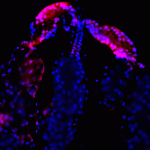Link to Pubmed [PMID] – 33649491
Link to DOI – 10.1038/s41598-021-84365-9
Sci Rep 2021 Mar; 11(1): 4883
Tick-borne flaviviruses (TBFVs) infect mammalian hosts through tick bites and can cause various serious illnesses, such as encephalitis and hemorrhagic fevers, both in humans and animals. Despite their importance to public health, there is limited epidemiological information on TBFV infection in Africa. Herein, we report that a novel flavivirus, Mpulungu flavivirus (MPFV), was discovered in a Rhipicephalus muhsamae tick in Zambia. MPFV was found to be genetically related to Ngoye virus detected in ticks in Senegal, and these viruses formed a unique lineage in the genus Flavivirus. Analyses of dinucleotide contents of flaviviruses indicated that MPFV was similar to those of other TBFVs with a typical vertebrate genome signature, suggesting that MPFV may infect vertebrate hosts. Bioinformatic analyses of the secondary structures in the 3′-untranslated regions (UTRs) revealed that MPFV exhibited unique exoribonuclease-resistant RNA (xrRNA) structures. Utilizing biochemical approaches, we clarified that two xrRNA structures of MPFV in the 3′-UTR could prevent exoribonuclease activity. In summary, our findings provide new information regarding the geographical distribution of TBFV and xrRNA structures in the 3′-UTR of flaviviruses.

